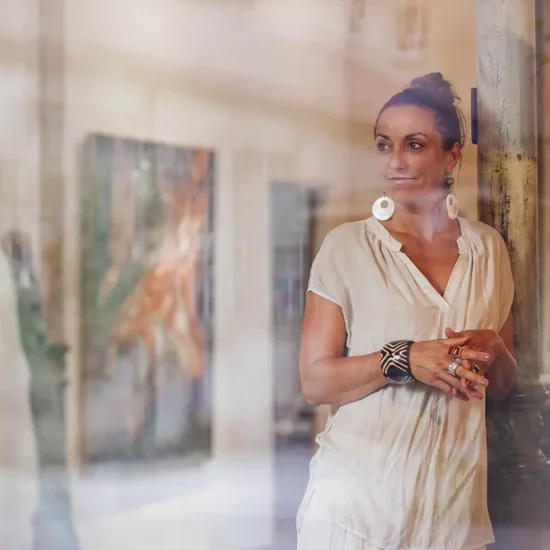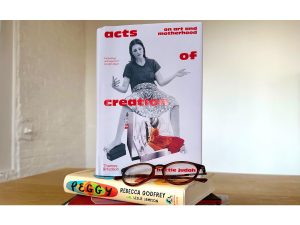The Crossroads of Culture and Creativity
Chantal Hediger, a full-time artist and mentor, has been painting for nearly three decades. Her Swiss-South African heritage deeply informs her art, creating a unique blend of Swiss precision and South African warmth. This cultural amalgamation is evident in her work, where structured techniques meet vibrant, expansive expressions. Hediger describes her art as a means of self-discovery, a way to understand life, humanity, and herself. For her, creating art is more than painting; it’s an exploration of identity and existence.
Hediger’s upbringing in a culturally diverse household instilled in her a profound appreciation for freedom and independence. These values are reflected in her art, where she constantly seeks to express her unrestrained creativity. Her journey from hobbyist to professional artist is a testament to her dedication and passion. Over the years, she transitioned from painting as a pastime to establishing a thriving art business, driven by a deep-seated need to express her innermost thoughts and emotions through her work.
Her dual heritage not only influences her artistic style but also shapes her worldview. The interplay of her Swiss roots and South African influences creates a dynamic tension in her art, characterized by a fusion of structured, geometric forms with fluid, organic elements. This blend mirrors her personal quest for freedom and independence, themes that resonate deeply in her work and life.
Chantal Hediger: From Picasso’s Influence to Personal Mastery
Growing up in an artistic family, Hediger was always surrounded by creativity. Her mother, an artist now living in California, significantly influenced her early artistic endeavors. Colors fascinated Hediger from a young age, but it was a lack of access to Picasso’s works that spurred her to start painting herself. This marked the beginning of her journey into the art world, a path that was anything but straightforward.
Despite her lifelong involvement with art, Hediger initially found the idea of a full-time career as an artist unimaginable. Various roles, including TV presenter, model, flight attendant, and art therapist, punctuated her journey. However, painting remained a constant in her life. After spending three years in Los Angeles pursuing an acting career, Hediger realized that painting was her true calling. This epiphany led her to fully embrace her identity as an artist, dedicating herself to both creating her own art and mentoring others to find their artistic voices.
Hediger’s artistic development was also significantly shaped by her mentor, who encouraged her to take bold, expressionistic steps. This mentorship helped her to merge various aspects of her identity and artistic influences into a cohesive style. Today, Hediger not only creates evocative works of art but also guides other artists in discovering their unique artistic expressions.
Exploring the Depths of the Human Condition
Hediger’s artistic style, figurative abstraction, primarily uses acrylics to explore the human condition. Inspired by the ancient Greek Oracle of Delphi’s maxim, “Know thyself,” her art serves as a mirror for self-reflection. Through her multi-layered, intuitive approach, Hediger delves into themes of human existence, blending intuition, perception, dreams, visions, and reality. Her works encourage viewers to explore their inner worlds, question established beliefs, and connect with their deepest desires.
Her process involves working in series, each centered around a specific theme, which allows her to delve deeply into various aspects of human experience. This method results in a diverse body of work, with each series presenting different stylistic elements. Her art is a celebration of vulnerability, sensuality, and emotional depth, capturing the interplay between the obvious and the underlying, the organic and the geometric, the physical and the spiritual.
A notable piece, “Daphne” from her “Living Nature” series, exemplifies this exploration. Created rapidly after years of gestation, “Daphne” holds a special place in Hediger’s heart. The painting symbolizes the transformative power of knowing oneself, echoing the Greek myth where Daphne achieves freedom by becoming a tree. For Hediger, this piece encapsulates the essence of true self-discovery and the liberation that comes from understanding one’s roots.
Chantal Hediger: The Sanctuary of Creation
Hediger’s workspace is a sanctuary where creativity thrives. She balances clear, methodical processes with chaotic, intuitive bursts of creativity, often alternating between working from sketches and drawing from emotional memory. Her studio, equipped with various tools and spaces, provides the flexibility needed for her diverse artistic practices. She creates an environment conducive to focus and inspiration, disconnecting from distractions like phone calls and social media to immerse herself fully in her work.
Her approach to art involves not only painting but also drawing and experimenting with different materials, though she primarily uses acrylics for their fast-drying properties and suitability to her layered style. Hediger’s studio is a cocoon of creativity, where even her cat plays a role in grounding her and bringing her into the present moment. The physical setup of her studio allows her to choose the perfect spot for each piece, ensuring that the environment aligns with the creative needs of the moment.
Influences from artists such as Edvard Munch, Egon Schiele, and Jenny Saville, along with inspiration from nature and humanity, deeply impact Hediger’s work. Her drive to understand herself and life at various levels fuels her artistic endeavors. Through her art, she seeks to remind viewers of their innate power and potential, encouraging them to pursue their paths with passion and authenticity.




